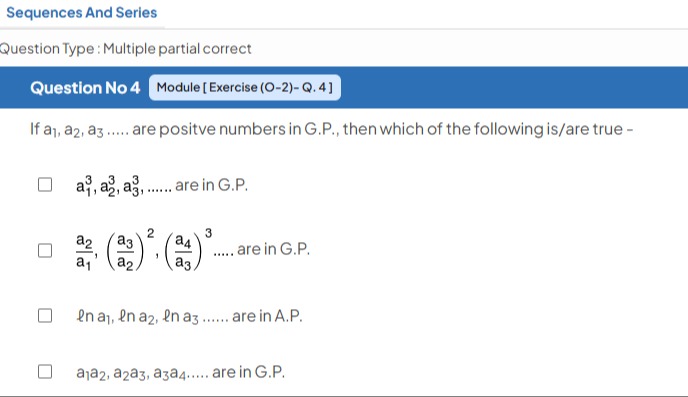Question
Question: If a₁, a₂, a₃ ...... are positve numbers in G.P., then which of the following is/are true -...
If a₁, a₂, a₃ ...... are positve numbers in G.P., then which of the following is/are true -

a13,a23,a33,...... are in G.P.
a1a2,(a2a3)2,(a3a4)3...... are in G.P.
lna1,lna2,lna3...... are in A.P.
a1a2,a2a3,a3a4...... are in G.P.
All four statements are true.
Solution
Let the given geometric progression (G.P.) be a1,a2,a3,…. Let a1 be the first term and r be the common ratio. Since ai are positive numbers, a1>0 and r>0. The general term of the G.P. is an=a1rn−1.
1. a13,a23,a33,...... are in G.P.
The terms of this sequence are bn=an3. Substitute an=a1rn−1: bn=(a1rn−1)3=a13(rn−1)3=a13r3(n−1). This is in the form A⋅Rn−1, where A=a13 and R=r3. Thus, a13,a23,a33,… is a G.P. with first term a13 and common ratio r3. This statement is TRUE.
2. a1a2,(a2a3)2,(a3a4)3...... are in G.P.
For a G.P., the ratio of consecutive terms is the common ratio r. So, anan+1=r. Let the terms of this new sequence be cn.
c1=a1a2=r
c2=(a2a3)2=r2
c3=(a3a4)3=r3
In general, cn=(anan+1)n=rn. The sequence is r,r2,r3,…. To check if it's a G.P., we find the ratio of consecutive terms: cncn+1=rnrn+1=r. Since the ratio is constant (r), this sequence is a G.P. with first term r and common ratio r. This statement is TRUE.
3. lna1,lna2,lna3...... are in A.P.
The terms of this sequence are dn=lnan. Substitute an=a1rn−1: dn=ln(a1rn−1). Using logarithm properties, ln(xy)=lnx+lny and ln(xy)=ylnx: dn=lna1+ln(rn−1)=lna1+(n−1)lnr. This is in the form A+(n−1)D, where A=lna1 and D=lnr. Thus, lna1,lna2,lna3,… is an A.P. with first term lna1 and common difference lnr. Since ai>0, lnai are well-defined. This statement is TRUE.
4. a1a2,a2a3,a3a4...... are in G.P.
The terms of this sequence are en=anan+1. Substitute an=a1rn−1 and an+1=a1rn: en=(a1rn−1)(a1rn)=a12rn−1+n=a12r2n−1. We can rewrite this as a12r2(n−1)+1=a12r⋅(r2)n−1. This is in the form A⋅Rn−1, where A=a12r and R=r2. Thus, a1a2,a2a3,a3a4,… is a G.P. with first term a12r and common ratio r2. This statement is TRUE.
All four statements are true.
